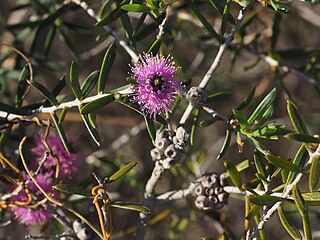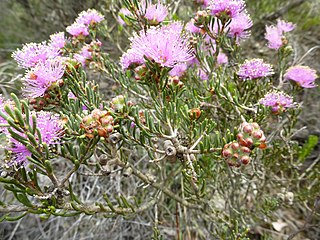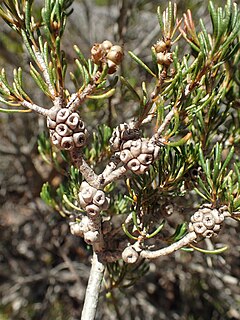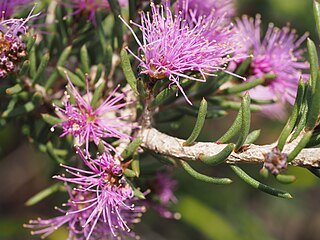
Melaleuca amydra is a plant in the myrtle family, Myrtaceae and is endemic to the south-west of Western Australia. It is similar to Melaleuca ryeae with its small, compact form, oval leaves and "pom-pom" heads of pink to purple flower heads on the ends of the branches in spring.

Melaleuca barlowii is a plant in the myrtle family, Myrtaceae and is endemic to the south-west of Western Australia. It is similar to a number of other Western Australian melaleucas such as M. conothamnoides with its purple pom-pom flower heads but is a more erect shrub with different leaves and the fruiting clusters have a different shape.

Melaleuca beardii is a plant in the myrtle family, Myrtaceae and is endemic to the south-west of Western Australia. It is similar to a number of other Western Australian melaleucas such as M. trichophylla with its purple pom-pom flower heads but unlike others, the tips of its leaves are rounded rather than pointed.
Melaleuca boeophylla is a plant in the myrtle family, Myrtaceae and is endemic to the south-west of Western Australia. It is similar to a number of other Western Australian melaleucas such as M. filifolia with its purple pom-pom flower heads but its leaves are shorter and oval in cross-section.

Melaleuca caeca is a plant in the myrtle family, Myrtaceae and is endemic to the south-west of Western Australia. It is similar to a number of other Western Australian melaleucas such as M. pentagona with its purple pom-pom flower heads but it is a smaller shrub with narrower leaves and smaller inflorescences.

Melaleuca carrii is a plant in the myrtle family, Myrtaceae and is endemic to the south-west of Western Australia. It is a small shrub similar to Melaleuca pentagona, with "pom-pom" heads of pinkish flowers and sharply pointed leaves but it is generally smaller, lacks a groove in its leaves and retains its petals on the flowers for longer than that species.

Melaleuca clavifolia is a plant in the myrtle family, Myrtaceae and is endemic to the south-west of Western Australia. It is a small shrub similar to Melaleuca tinkeri, with "pom-pom" heads of pinkish flowers and soft, silky hairs on the new growth but it has larger flower heads and its leaves are shorter, more club-shaped and have less distinct oil glands.

Melaleuca calyptroides is a plant in the myrtle family, Myrtaceae and is endemic to the south-west of Western Australia. It is similar to a number of other Western Australian melaleucas such as M. hollidayi with its almost cylindrical leaves, purple pom-pom flower heads and low growth habit but it has longer, wartier leaves and fewer flowers in the inflorescences. The floral cup and woody capsule from which it develops are longer than those of similar melaleucas.Melaleuca calyptroides close.jpg

Melaleuca eurystoma is a plant in the myrtle family, Myrtaceae and is endemic to the south of Western Australia. It is a small shrub with pale lemon to greenish flowers and egg-shaped to almost oval leaves.

Melaleuca glena is a plant in the myrtle family, Myrtaceae and is endemic to the south of Western Australia. It is similar to the commonly cultivated Melaleuca nesophila with its purple "pom-pom" flower heads but is a smaller shrub with the inflorescences much more often on the sides of the branches and only occasionally on the ends.

Melaleuca hnatiukii is a plant in the myrtle family, Myrtaceae and is endemic to the south of Western Australia. It is a medium to large shrub with arching branches, prickly tipped leaves and creamy-white heads of flowers in spring or early summer.

Melaleuca huttensis is a plant in the myrtle family Myrtaceae, and is endemic to the south-west of Western Australia. It is a small, woody shrub with elliptic leaves, mostly crowded near the ends of the branches which are tipped with heads of white or yellow flowes during spring and early summer. It is a threatened species, potentially endangered by the construction of the Oakajee Port near Geraldton.

Melaleuca leuropoma is a plant in the myrtle family, Myrtaceae and is endemic to the south-west of Western Australia. It is a small to medium-sized shrub which flowers over an extended period with flower colour varying from purple to yellow or white. The glossy, often brown petals covering the flower buds are also an unusual characteristic of this species.

Melaleuca linguiformis is a plant in the myrtle family, Myrtaceae and is endemic to the south of Western Australia. It is a shrub with hairy new growth, small leaves and heads of white flowers similar to Melaleuca teuthidoides shorter sepals and more stamens in each flower.

Melaleuca osullivanii is a plant in the myrtle family, Myrtaceae and is endemic to the south-west of Western Australia. It was first formally described in 2004 after a review of the broombush group, Melaleuca uncinata. It differs from others in the group by having leaves that are fine and circular in cross section. The closest other broombrush is Melaleuca hamata whose leaves are 0.8–1.6 mm (0.03–0.06 in) in diameter compared to 0.7–0.9 mm (0.03–0.04 in) for this species.
Melaleuca procera is a plant in the myrtle family, Myrtaceae and is endemic to the south-west of Western Australia. It is an erect, spindly shrub with cylinder-shaped leaves and heads of pinkish flowers in later spring or early summer.

Melaleuca ryeae is a plant in the myrtle family, Myrtaceae and is endemic to the south west of Western Australia. It is a small shrub, closely resembling Melaleuca amydra with its small leaves and profuse heads of pink to purple flowers but M.amydra has narrower leaves and does not have spherical clusters of fruits.
Melaleuca similis is a plant in the myrtle family, Myrtaceae and is endemic to the south west of Western Australia. It is a small shrub, similar to Melaleuca stramentosa with its narrow, almost cylindrical leaves and heads of pink to purple flowers but lacks the matted, silky hairs on the young leaves and outer edge of the flower cup.

Melaleuca papillosa is a plant in the myrtle family, Myrtaceae and is endemic to the south-west of Western Australia. It is one of the smallest species of Melaleuca, distinguished by its narrow, usually hairy, pimply leaves, small heads of pink to purple flowers surrounded by silky hairs and scattered rather than clustered fruits.
Melaleuca stramentosa is a plant in the myrtle family, Myrtaceae and is endemic to the south-west of Western Australia. It is a small, bushy shrub similar to Melaleuca similis with its cylindrical leaves and heads of pink to purple flowers but differs in have matted, woolly hairs around the flowers and on the young leaves.


















